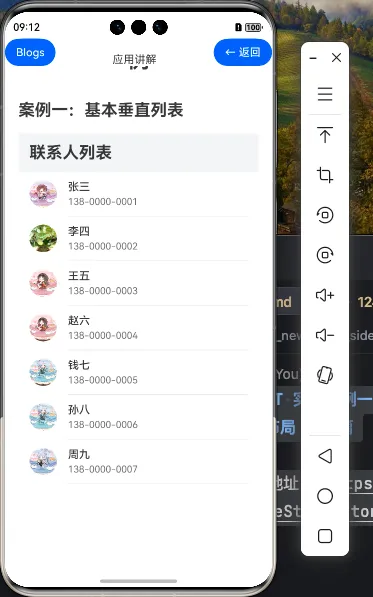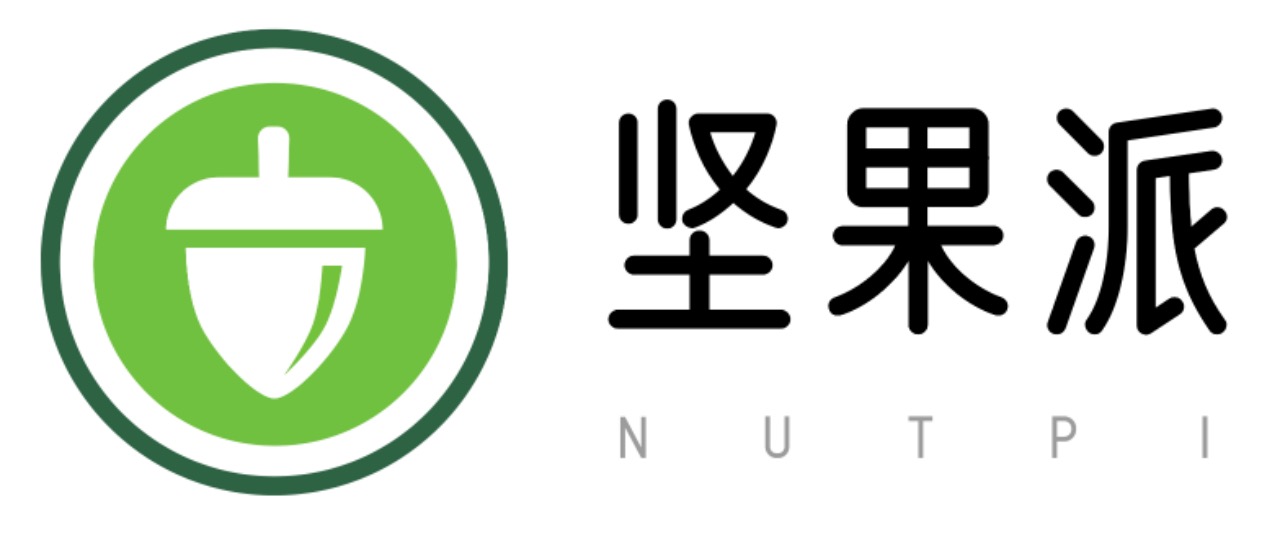134.[HarmonyOS NEXT 实战案例六:List系列] 垂直列表组件实战:打造高效联系人列表 进阶篇
2025-06-30 22:12:35
236次阅读
0个评论
[HarmonyOS NEXT 实战案例六:List系列] 垂直列表组件实战:打造高效联系人列表 进阶篇
项目已开源,开源地址: https://gitcode.com/nutpi/HarmonyosNextCaseStudyTutorial , 欢迎fork & star
效果演示

一、List组件进阶特性
在基础篇中,我们已经学习了如何创建一个简单的垂直联系人列表。在本篇教程中,我们将深入探讨List组件的进阶特性,包括列表交互、状态管理、样式定制等方面。
1.1 List组件的进阶属性
| 属性 | 说明 | 用途 |
|---|---|---|
| scrollBar | 设置滚动条样式 | 控制滚动条的显示和外观 |
| edgeEffect | 设置边缘效果 | 控制列表到达边缘时的视觉反馈 |
| chainAnimation | 设置链式动画 | 控制列表项的连锁动画效果 |
| multiSelectable | 设置多选模式 | 允许用户选择多个列表项 |
| sticky | 设置吸顶效果 | 使特定列表项在滚动时保持在顶部 |
| cachedCount | 设置缓存数量 | 控制预加载的列表项数量 |
1.2 ListItem的进阶特性
| 特性 | 说明 | 用途 |
|---|---|---|
| selectable | 设置是否可选 | 控制列表项是否可被选中 |
| selected | 设置选中状态 | 控制列表项的选中状态 |
| swipeAction | 设置滑动操作 | 实现滑动显示操作按钮的功能 |
二、联系人列表的交互增强
在基础版本的联系人列表基础上,我们可以添加更多的交互功能,使列表更加实用和用户友好。
2.1 添加列表项选中效果
我们可以为联系人列表项添加选中效果,当用户点击列表项时,该项会显示为选中状态:
@Component
export struct AdvancedVerticalList {
// 联系人数据
private contacts:ContactType[] = [...] // 与基础版相同
// 当前选中的联系人索引
@State selectedIndex: number = -1
build() {
Column() {
// 标题栏(与基础版相同)
// 联系人列表
List() {
ForEach(this.contacts, (contact:ContactType, index: number) => {
ListItem() {
Row() {
// 头像和联系人信息(与基础版相同)
}
.width('100%')
.padding({ left: 16, right: 16, top: 12, bottom: 12 })
.backgroundColor(this.selectedIndex === index ? '#F0F0F0' : '#FFFFFF')
}
.height(64)
.onClick(() => {
this.selectedIndex = index
// 可以在这里添加其他操作,如显示详情等
})
})
}
// List属性设置(与基础版相同)
}
// Column属性设置(与基础版相同)
}
}
在这个示例中:
- 添加了一个@State装饰的selectedIndex状态变量,用于跟踪当前选中的联系人索引
- 在Row组件上添加了backgroundColor属性,根据selectedIndex动态设置背景色
- 为ListItem添加了onClick事件处理函数,点击时更新selectedIndex
2.2 实现列表项滑动操作
在移动应用中,滑动列表项显示操作按钮是一种常见的交互模式。我们可以使用ListItem的swipeAction属性来实现这一功能:
ListItem() {
Row() {
// 头像和联系人信息(与基础版相同)
}
.width('100%')
.padding({ left: 16, right: 16, top: 12, bottom: 12 })
}
.height(64)
.swipeAction({
end: this.getDeleteButton(index), // 右侧滑出的删除按钮
start: this.getCallButton(index) // 左侧滑出的拨打电话按钮
})
其中,getDeleteButton和getCallButton是自定义的Builder函数:
@Builder getDeleteButton(index: number) {
Button({
type: ButtonType.Capsule
}) {
Image($r('app.media.ic_delete'))
.width(24)
.height(24)
}
.width(40)
.height(40)
.backgroundColor('#FF4081')
.margin(12)
.onClick(() => {
// 实现删除联系人的逻辑
this.contacts.splice(index, 1)
})
}
@Builder getCallButton(index: number) {
Button({
type: ButtonType.Capsule
}) {
Image($r('app.media.ic_call'))
.width(24)
.height(24)
}
.width(40)
.height(40)
.backgroundColor('#4CAF50')
.margin(12)
.onClick(() => {
// 实现拨打电话的逻辑
console.info(`拨打电话:${this.contacts[index].phone}`)
})
}
2.3 添加列表滚动控制
我们可以添加控制列表滚动的功能,例如滚动到顶部或特定位置:
@Component
export struct AdvancedVerticalList {
// 联系人数据和状态变量
// 列表控制器
private listController: ListController = new ListController()
build() {
Column() {
// 标题栏
Row() {
Text('联系人列表')
.fontSize(24)
.fontWeight(FontWeight.Bold)
Blank()
Button('回到顶部')
.fontSize(14)
.onClick(() => {
this.listController.scrollTo(0)
})
}
.width('100%')
.height(56)
.padding({ left: 16, right: 16 })
.backgroundColor('#F1F3F5')
// 联系人列表
List({ space: 0, controller: this.listController }) {
// 列表内容(与之前相同)
}
// List属性设置(与基础版相同)
}
// Column属性设置(与基础版相同)
}
}
在这个示例中:
- 创建了一个ListController实例,用于控制列表的滚动
- 在List组件的构造参数中传入controller
- 在标题栏添加了一个"回到顶部"按钮,点击时调用scrollTo方法滚动到列表顶部
三、列表样式进阶定制
除了基本的样式设置外,我们还可以对列表进行更多的样式定制,使其更加美观和符合应用的设计风格。
3.1 自定义滚动条
List() {
// 列表内容
}
.width('100%')
.layoutWeight(1)
.divider({
strokeWidth: 1,
color: '#E5E5E5',
startMargin: 72,
endMargin: 16
})
.scrollBar({
width: 4,
color: '#66000000',
shape: ScrollBarShape.Rectangle
})
滚动条配置说明:
| 属性 | 值 | 说明 |
|---|---|---|
| width | 4 | 滚动条宽度为4像素 |
| color | '#66000000' | 滚动条颜色为半透明黑色 |
| shape | ScrollBarShape.Rectangle | 滚动条形状为矩形 |
3.2 自定义边缘效果
List() {
// 列表内容
}
.width('100%')
.layoutWeight(1)
.divider({
strokeWidth: 1,
color: '#E5E5E5',
startMargin: 72,
endMargin: 16
})
.edgeEffect(EdgeEffect.Spring) // 设置边缘效果为弹簧效果
EdgeEffect枚举值说明:
| 值 | 说明 |
|---|---|
| EdgeEffect.Spring | 弹簧效果,列表会有回弹动画 |
| EdgeEffect.None | 无效果 |
| EdgeEffect.Fade | 淡出效果 |
3.3 链式动画效果
List() {
// 列表内容
}
.width('100%')
.layoutWeight(1)
.divider({
strokeWidth: 1,
color: '#E5E5E5',
startMargin: 72,
endMargin: 16
})
.chainAnimation(true) // 启用链式动画
启用链式动画后,列表项会在滚动时产生连锁的动画效果,增强视觉体验。
四、列表状态管理
在实际应用中,列表的状态管理是一个重要的方面,包括数据的增删改查、选中状态管理等。
4.1 实现联系人搜索功能
我们可以添加一个搜索框,用于筛选联系人列表:
@Component
export struct AdvancedVerticalList {
// 联系人数据
private contacts:ContactType[] = [...] // 与基础版相同
// 搜索关键词
@State searchText: string = ''
// 获取筛选后的联系人列表
private getFilteredContacts(): ContactType[] {
if (!this.searchText) {
return this.contacts
}
return this.contacts.filter(contact =>
contact.name.includes(this.searchText) ||
contact.phone.includes(this.searchText)
)
}
build() {
Column() {
// 标题栏
Row() {
Text('联系人列表')
.fontSize(24)
.fontWeight(FontWeight.Bold)
}
.width('100%')
.height(56)
.padding({ left: 16 })
.backgroundColor('#F1F3F5')
// 搜索框
TextInput({ placeholder: '搜索联系人', text: this.searchText })
.width('90%')
.height(40)
.margin({ top: 8, bottom: 8 })
.onChange((value: string) => {
this.searchText = value
})
// 联系人列表
List() {
ForEach(this.getFilteredContacts(), (contact:ContactType, index: number) => {
// 列表项内容(与基础版相同)
})
}
// List属性设置(与基础版相同)
}
// Column属性设置(与基础版相同)
}
}
在这个示例中:
- 添加了一个@State装饰的searchText状态变量,用于存储搜索关键词
- 添加了getFilteredContacts方法,根据searchText筛选联系人
- 在Column中添加了TextInput组件作为搜索框
- 在ForEach中使用getFilteredContacts()替代原来的this.contacts
4.2 实现联系人分组
在大型联系人列表中,通常会按照字母或其他规则对联系人进行分组。我们可以使用ListItemGroup组件来实现这一功能:
@Component
export struct AdvancedVerticalList {
// 联系人数据(按首字母排序)
private contacts:ContactType[] = [...] // 与基础版相同,但已排序
// 获取分组后的联系人数据
private getGroupedContacts(): { [key: string]: ContactType[] } {
const grouped: { [key: string]: ContactType[] } = {}
this.contacts.forEach(contact => {
const firstLetter = contact.name.charAt(0).toUpperCase()
if (!grouped[firstLetter]) {
grouped[firstLetter] = []
}
grouped[firstLetter].push(contact)
})
return grouped
}
build() {
Column() {
// 标题栏(与基础版相同)
// 联系人列表(分组显示)
List() {
ForEach(Object.keys(this.getGroupedContacts()).sort(), (letter: string) => {
ListItemGroup({
header: this.getGroupHeader(letter)
}) {
ForEach(this.getGroupedContacts()[letter], (contact:ContactType) => {
ListItem() {
// 列表项内容(与基础版相同)
}
.height(64)
})
}
})
}
// List属性设置(与基础版相同)
}
// Column属性设置(与基础版相同)
}
@Builder getGroupHeader(letter: string) {
Text(letter)
.fontSize(16)
.fontWeight(FontWeight.Bold)
.backgroundColor('#F0F0F0')
.width('100%')
.padding(8)
}
}
在这个示例中:
- 添加了getGroupedContacts方法,将联系人按首字母分组
- 使用ForEach遍历分组的键(字母)
- 对每个字母组使用ListItemGroup组件
- 使用getGroupHeader Builder函数创建组标题
总结
在本篇教程中,我们深入探讨了HarmonyOS NEXT的List组件的进阶特性和用法。我们学习了如何:
- 使用List和ListItem的进阶属性增强列表功能
- 添加列表项选中效果和滑动操作
- 实现列表滚动控制
- 自定义列表样式,包括滚动条、边缘效果和链式动画
- 实现联系人搜索和分组功能
00
- 0回答
- 5粉丝
- 0关注
相关话题
- [HarmonyOS NEXT 实战案例六:List系列] 垂直列表组件实战:打造高效联系人列表 基础篇
- 144.[HarmonyOS NEXT 实战案例十:List系列] 字母索引列表组件实战:打造高效联系人应用 进阶篇
- 143.[HarmonyOS NEXT 实战案例十:List系列] 字母索引列表组件实战:打造高效联系人应用 基础篇
- [HarmonyOS NEXT 实战案例三:SideBarContainer] 侧边栏容器实战:社交应用联系人列表 进阶篇
- 140.[HarmonyOS NEXT 实战案例八:List系列] 滑动操作列表组件实战:打造高效待办事项应用 进阶篇
- 142.[HarmonyOS NEXT 实战案例九:List系列] 分组列表组件实战:打造分类设置菜单 进阶篇
- 150.[HarmonyOS NEXT 实战案例十一:List系列] 下拉刷新和上拉加载更多列表组件实战:打造高效新闻应用 进阶篇
- 138.[HarmonyOS NEXT 实战案例七:List系列] 多列列表组件实战:打造精美应用推荐页 进阶篇
- 152.[HarmonyOS NEXT 实战案例十二:List系列] 卡片样式列表组件实战:打造精美电商应用 进阶篇
- [HarmonyOS NEXT 实战案例三:SideBarContainer] 侧边栏容器实战:社交应用联系人列表 基础篇
- 148.[HarmonyOS NEXT 实战案例八 :List系列] 粘性头部列表进阶篇
- 156.[HarmonyOS NEXT 实战案例十二 :List系列] 聊天消息列表 - 进阶篇
- 136.[HarmonyOS NEXT 实战案例七:List系列] 水平列表组件实战:打造精美图片库 进阶篇
- 146.[HarmonyOS NEXT 实战案例七 :List系列] 可选择列表进阶篇
- 154.[HarmonyOS NEXT 实战案例十一 :List系列] 自定义内容列表 - 进阶篇
